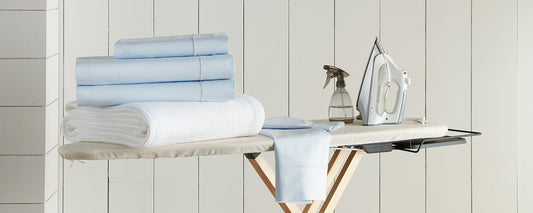Properly storing bedding safeguards your bedding from damage. It also helps maintain freshness and hygiene and can even save space and time–an organized storage system makes it easy to change your bedding quickly! Not to mention, fresh, clean bedding creates a more comfortable sleep experience for you and your guests.
Read on to discover the best tips and tricks for storing bedding. We'll also share how to avoid common mistakes. Here's what you need to know for a better storage system.
Preparing Bedding for Storage

Before storing bedding, ensure all sheets, duvets, blankets, and other linens are clean, dry, and in good condition. That way, you're not unknowingly packing away bedding filled with dust, oil, and dead skin from previous use.
Check for Damage
Now's also a good time to inspect each piece of bedding for signs of wear and tear. Check for holes, pilling, and frayed edges. Treat any stains or odors and patch up any rips to prevent further damage. If everything looks to be in excellent condition, go an extra step and run a lint roller over your bedding to remove stray hair, pet dander, or other irritants.
Ensure All Bedding is Dry
Once you've inspected, treated, and cleaned your bedding, ensure all pieces are completely dry. Excess moisture can cause mold, mildew, and odors to grow in storage.
With larger bedding, like comforters and duvets, try not to overload the dryer so the pieces dry evenly. Wool dryer balls can also keep the bedding from bunching up, helping with faster and more efficient drying. Air drying outside can also add a fresh sun-kissed scent to your bedding and may be best for more delicate pieces. (As always, check your bedding's label for care instructions.)
Choosing the Right Storage Options
Now that your bedding is clean and dry, it’s time to select your type of storage. The best way to store bedding will depend on the space you have in your home, the kind of bedding you have, and how often you’re using it.
Consider Your Space
If space isn’t an issue, consider storing your bedding in the following areas:
- Linen closets are convenient for folded sheets, blankets, and pillows. They also provide plenty of airflow and breathability.
- Dresser drawers make excellent storage space for sheets and pillowcases.
- Shelving units provide flexible and custom storage to suit your needs.
For homes with limited storage space, here are a few storage options to consider:
- Vacuum-sealed bags can save significant space by compressing bulky bedding like comforters, duvets, and pillows.
- Under-bed storage is a smart way to maximize otherwise unused storage space. Store your bedding in drawers, bins, or rolling carts beneath your bed.
- Multi-purpose furniture, like ottomans with storage compartments, works well if you have limited space.
What Type of Bedding Are You Storing?
The kind of bedding you're storing will also affect what storage options you use. For example:
- Silk and other delicate fabrics store well in breathable fabric bags or baskets, which help prevent moisture buildup.
- Down and down alternatives are best stored in breathable bags and covers, too, as airtight containers can trap moisture. Bedding that’s compressed too tightly can also damage the duvet’s loft.
- Wool is best in cedar chests or bags with cedar lining to prevent moth damage.
- Cotton should have plenty of air circulation. It shouldn’t be in plastic bags for long periods to avoid trapping moisture and musty odors.
- Linen should be well-ventilated and have plenty of air circulation to prevent mildew and wrinkles.
How Often Are You Using It?
For bedding you use seasonally or occasionally, use airtight containers and vacuum-sealed bags. These storage options will help keep your bedding free of dust and pests between use. For bedding you use more regularly, opt for more accessible storage options, such as open shelves and drawers.
Should Bedding Be Stored in Plastic or Fabric Containers?
Fabric containers are typically the ideal choice for storing bedding because they’re:
- Breathable - Proper air circulation helps stop moisture from building up and causing mildew and mold (especially crucial for bedding made of natural fibers).
- Safe for delicate items - Fabric containers are less likely to discolor or damage silk or other delicate linens.
- More environmentally friendly - Fabric containers are often made from cotton, canvas, or other natural materials.
That said, plastic containers also come with their own set of perks since they’re:
- Durable - Made of plastic, these containers are sturdy and more resistant to wear and tear and pests.
- Space-saving - Options like vacuum-sealed bags efficiently reduce the storage space needed.
- Affordable - Plastic containers are typically more budget-friendly than fabric containers.
Best Locations to Store Bedding

The best place to store your bedding is in a dark, dry area, like a closet, drawer, or chest. Avoid areas like attics and garages, which are more susceptible to moisture and pests like mice and bugs. High-humidity areas can also cause mold, mildew, and musty odors.
Avoiding direct sunlight will also help prevent fading, yellowing, and dark spots. Plus, keeping your bedding away from windows will help stop insect damage, and placing it away from vents and other heating sources will prevent damage and fading.
You'll also want to store your bedding in a location that doesn't experience temperature fluctuations. Constant temperature shifts can weaken the material, making it become brittle and lose shape.
Seasonal Rotation Tips
Rotating your stored bedding and using your sets evenly can help prevent wear and tear on one particular set, reduce washing times, and ensure you always have a clean, fresh set ready to use.
To establish a rotation system:
- Label each bedding set with a number or letter.
- Create a rotating schedule based on how many sets you have to ensure each gets used frequently.
- Arrange your stored bedding in the order you'll use them, from top to bottom or left to right.
Maintaining Freshness in Storage
To keep bedding fresh in storage, use natural deodorizers like lavender sachets and cedar blocks. Stick to your rotation schedule, or periodically take your bedding out of storage and hang it outside in the fresh air.
Natural deodorizers, like lavender, cloves, and cedar chips, can also help repel moths and other insects. (Avoid using moth balls as they can damage your bedding and are toxic if swallowed. Hello, curious kids and pets. Plus, they smell funky!)
Conclusion
Storing your high-end bedding can help preserve elegance season after season. The best way to store your bedding long-term is to ensure it’s completely clean and dry, stored in a dark, dry area, and placed in breathable storage containers.
At Peacock Alley, we believe that luxury linens should be livable and long-lasting. When you treat your bedding with care, you can feel confident it will stand the test of time. For more expert insight on how to wash and care for your bedding, check out our in-depth professional care guides.
Frequently Asked Bedding Storage Questions
Q: What is the best way to store bedding long-term?
A: The best way to store bedding long-term is first to prepare your bedding. Wash and dry it thoroughly to remove dirt, dust, and dander and prevent mold and mildew. Next, store your bedding in a cool, dry, dark area. Use breathable storage options like cotton bags or hang bulkier bedding in a closet. Vacuum-sealed bags can help if you have limited storage space.
Q: How often should I rotate stored bedding?
A: Rotate stored bedding every few months to keep it smelling fresh. Rotate bedding sets if you have multiple. Sticking to a rotation schedule will keep things smelling fresh and prevent wear and tear on one particular set.
Q: Can I store bedding in the attic or basement?
A: Storing bedding in the attic or basement is generally not advised as these areas tend to be damp, be more prone to pests, and experience extreme temperature fluctuations–all of which can damage bedding. Instead, store your bedding in a dark, dry area like a closet, chest, or drawer. Or utilize the space under your bed if your room has limited storage.






















